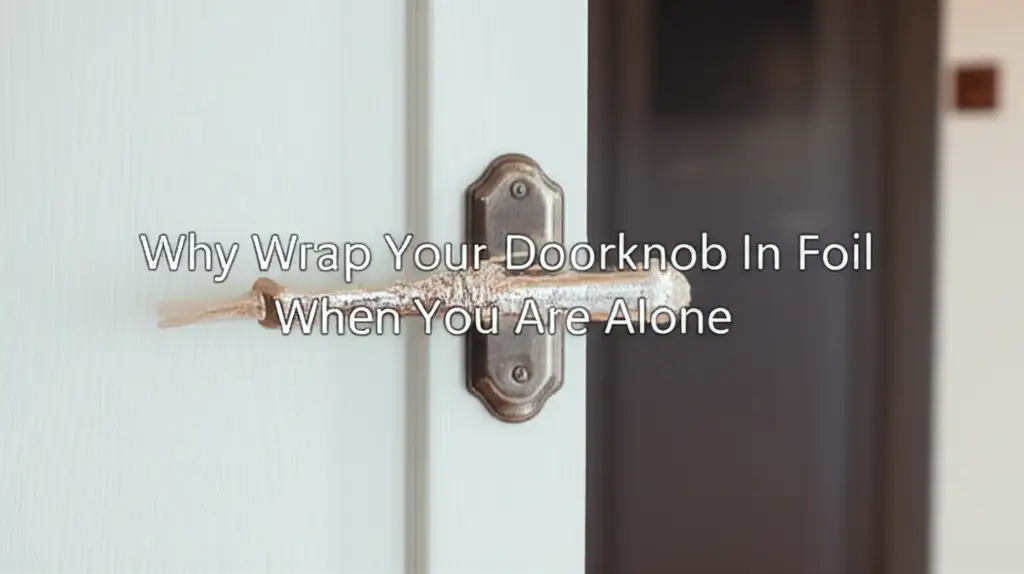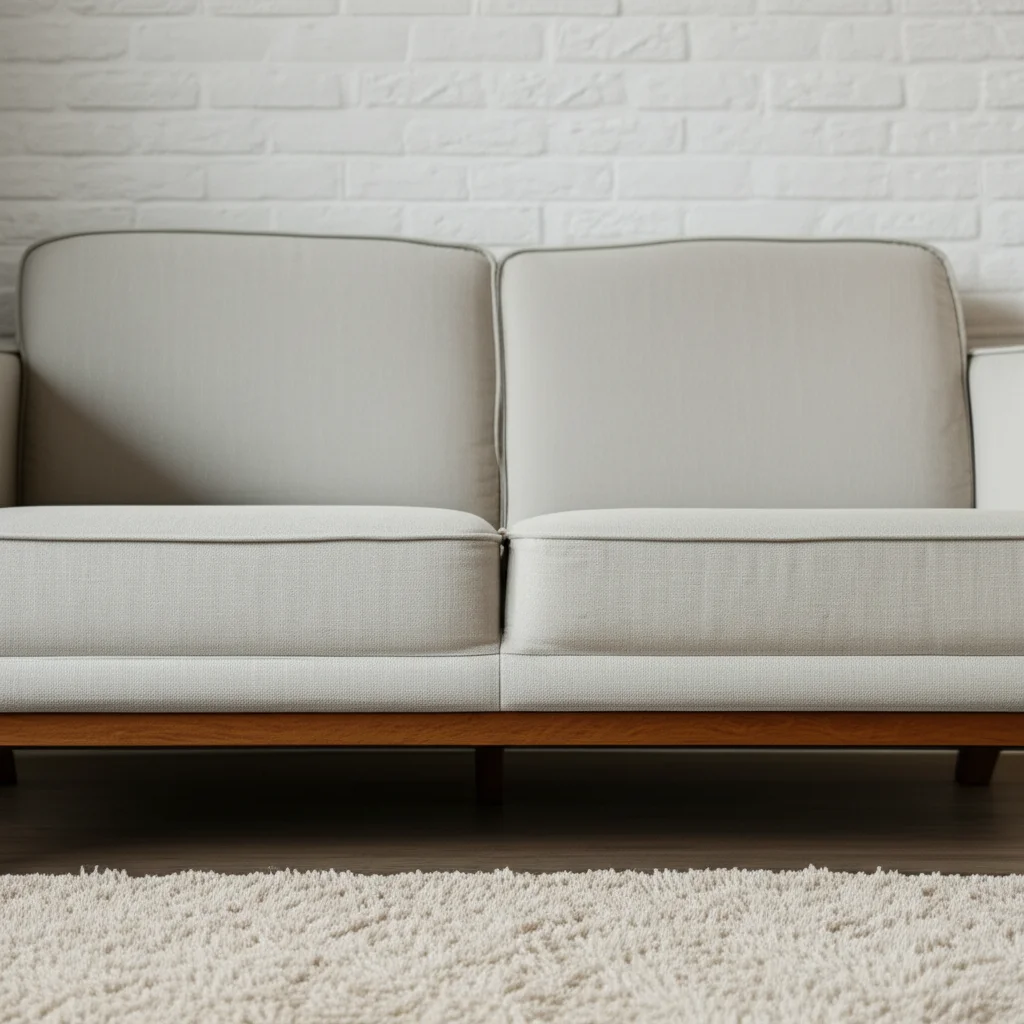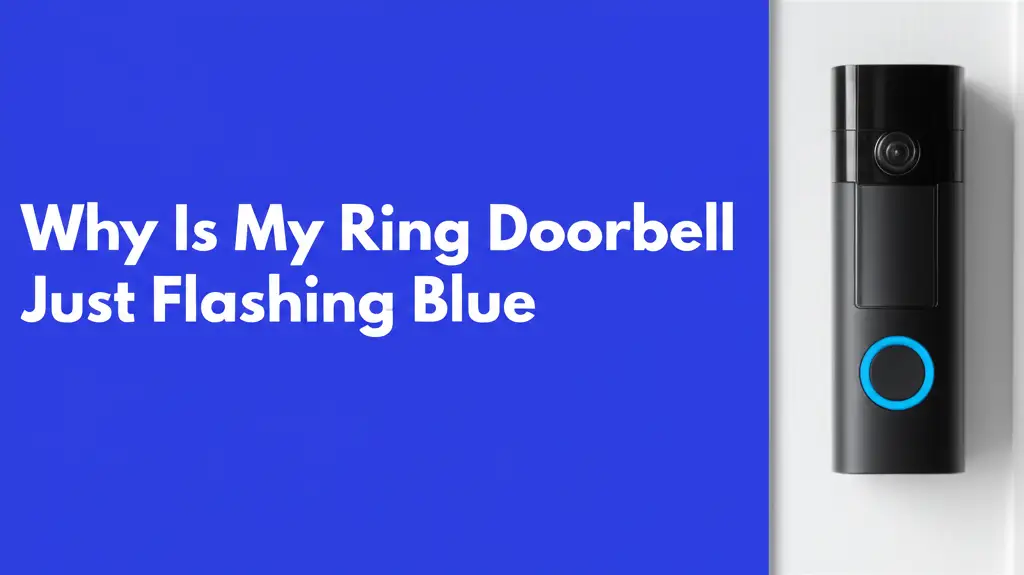· Katria Melrose · Home Tips · 14 min read
Why Wrap Your Doorknob In Foil When You Are Alone

Protecting Your Space: Why Wrap Your Doorknob in Foil?
Have you ever considered wrapping your doorknob in foil when you are alone? This might seem like a strange idea at first glance. However, there are several surprising and practical reasons why someone might choose to do this. This simple act can offer unexpected benefits, from managing everyday annoyances to providing a sense of security.
When you are alone at home, small adjustments can make a big difference in comfort and safety. Wrapping a doorknob in aluminum foil is one such unconventional trick that people use for various purposes. This article explores the unexpected advantages of this practice. We will look at how it helps with static electricity, acts as a temporary deterrent, and even serves as a simple protective barrier.
Takeaway:
- Wrapping a doorknob in foil helps reduce static electricity shocks.
- It provides a temporary, noisy barrier against unwanted entry.
- Foil protects doorknob finishes from paint or damage.
- It serves as a visual “do not disturb” signal.
- Some use it as a simple, temporary child safety measure.
People wrap their doorknobs in foil when alone for practical reasons like preventing static electricity shocks, creating a temporary noise alarm against intruders, protecting a newly painted doorknob, or marking a room as occupied without a formal sign. It offers simple, immediate solutions.
Managing Static Electricity with Doorknob Foil
One common and frustrating issue many people face, especially during dry seasons, is static electricity. You reach for a doorknob, and suddenly, you feel a sharp, unpleasant shock. This happens when your body builds up an electrical charge, and the metal doorknob provides a path for that charge to release quickly. Wrapping your doorknob in foil can help mitigate this problem.
Aluminum foil is a conductor of electricity. When you wrap it around a doorknob, it can help dissipate the static charge gradually. This prevents a sudden discharge when you touch the handle. The foil acts as a larger surface area, allowing the static to spread out before you make contact. This simple trick provides relief from those annoying shocks.
Using foil for static is especially helpful in winter months. The air is drier then, which makes static buildup more common. If you often experience shocks from your doorknobs, trying this method can offer a quick solution. It creates a temporary ground, making your daily interactions with doorknobs more pleasant.
This concept relates to how static electricity forms and discharges. You can learn more about how static electricity behaves in colder, drier conditions by exploring why doorknob shocks and static clothing are most common during winter months. Understanding the science behind it helps you appreciate simple fixes like using foil. Many people find this a highly effective, low-cost solution for a pervasive problem.
Temporary Deterrent: Foiling Unwanted Entry
When you are alone, a sense of security is important. While wrapping your doorknob in foil is not a high-security measure, it can act as a surprising temporary deterrent. An opportunistic intruder might notice the unusual setup and think twice before trying to open the door. The crinkling sound of foil also plays a role in this strategy.
If someone attempts to turn the doorknob, the foil will crinkle loudly. This sudden noise can alert you to their presence. It gives you a crucial few seconds to react or prepare. For someone trying to be stealthy, any unexpected noise is a major giveaway.
This method works best for interior doors or as an added layer of peace of mind on an exterior door that is already locked. It is not a replacement for strong locks or alarm systems. However, as a quick, last-minute measure when you are alone, it provides a simple visual and auditory alert. It makes an unwelcome visitor think you are aware and watching.
Think of it as a low-tech tripwire for your doorknob. It tells an intruder that someone inside is mindful of their surroundings. This small step can make a difference in how secure you feel in your space, especially when you are the only one home. It adds an element of surprise for anyone trying to enter without permission.
Protecting Doorknob Finishes from Damage
Sometimes, you need to protect a doorknob from accidental damage or spills. For instance, when painting a room, it is easy to get paint on the doorknob. Covering the doorknob with foil before you start painting ensures it stays clean. This saves you the trouble of scraping off dried paint later.
Foil creates a simple, effective barrier around the entire doorknob. It conforms easily to the shape, providing full coverage. This protective layer is quick to apply and remove, making it ideal for temporary projects. It guards against drips, splatters, and accidental scratches.
This protection extends beyond just painting. If you are doing dusty work, like sanding nearby, foil keeps dust out of the doorknob’s mechanisms. It also protects delicate finishes from harsh cleaning agents. Using foil is a practical way to maintain the look and function of your doorknobs without much effort.
Many household items benefit from temporary wrapping for protection during various tasks. For instance, knowing how to wrap a sofa for storage can protect it from dust and moisture. Similarly, when you need to store large items like a mattress, wrapping helps preserve its condition, just as how to wrap mattress for moving ensures it stays clean. Foil on a doorknob is a smaller-scale application of this same protective principle.
Creating a Temporary “Do Not Disturb” Signal
When you are alone in your home, you might want to ensure you are not disturbed. Perhaps you are working, meditating, or simply enjoying quiet time. Wrapping your doorknob in foil serves as an unconventional but effective “do not disturb” sign. It is a visual cue that signals a desire for privacy.
This method is especially useful in shared living spaces, even if you are alone in your specific room. If family members or roommates might return, the foil communicates your need for uninterrupted time. It stands out visually, making it hard to ignore. It is a clear, yet non-verbal, message.
The unusual nature of the foil makes people curious. They are more likely to pause and consider why it is there. This gives you a moment to decide if you want to engage or if you truly need uninterrupted quiet. It is a simple way to set boundaries without confrontation.
Sometimes, a quick visual signal is all you need. This is a practical tip for maintaining your solitude and focus. It prevents accidental interruptions and allows you to fully immerse yourself in your activity. The foil effectively says, “Please respect my quiet time.”
Unconventional Pest Deterrent Methods
Some people believe that aluminum foil can deter certain pests, particularly rodents. The crinkling sound, the unusual texture, or even the reflective surface might be unsettling to them. While there is not extensive scientific proof for this, some anecdotal evidence suggests it can work as a temporary barrier. When you are alone, a slight fear of pests can feel more pronounced.
Wrapping a doorknob in foil might deter small pests from entering a specific room through the gaps around the door. The foil can create an unpleasant surface for them to navigate. It is a low-cost experiment for those who suspect pest activity near their doors. It provides a simple, physical obstacle.
Rodents are often sensitive to new textures and sounds. The foil’s distinct feel and the noise it makes when disturbed might encourage them to seek an easier path. This method is often used in combination with other pest control strategies, not as a standalone solution. It offers a complementary layer of protection.
Using household items for pest control is not uncommon. Many people use foil for various cleaning tasks, highlighting its versatility. For example, foil is excellent for deep cleaning tasks like how to clean oven racks with aluminum foil or making how to clean grill grates with aluminum foil spotless. This shows foil’s multi-faceted nature in practical home applications, extending even to deterring pests.
Addressing Superstitions and Folklore
Beyond practical reasons, some people wrap doorknobs in foil due to superstitions or folklore. Throughout history, various cultures have used common household items for protection or good luck. Foil, with its reflective and conductive properties, sometimes gets associated with these beliefs. When you are alone, such beliefs can offer a sense of comfort.
Some folklore suggests that reflective surfaces can ward off negative energies or spirits. The logic is that the reflection sends bad intentions back to their source. While not scientifically proven, these beliefs offer psychological comfort to those who hold them. For some, it is a small ritual that brings peace of mind.
Other beliefs tie foil to protection from specific entities or bad luck. Placing foil on a doorknob might be seen as a way to create a barrier against unwanted influences entering the home. This falls into the category of personal practices that provide a feeling of safety and control. It is a modern twist on ancient protective charms.
Understanding these beliefs shows how human ingenuity and comfort often intertwine. It highlights the diverse reasons behind seemingly unusual actions. Whether for practical use or a touch of folklore, wrapping your doorknob in foil remains a unique, personal choice. It is a testament to how people adapt and find comfort in their surroundings.
Temporary Child Safety Measure
For parents or caregivers, ensuring a child’s safety is a top priority. When you are alone with a young child, temporary safety measures can be incredibly helpful. While not a permanent solution, wrapping a doorknob in foil can serve as a simple, short-term child safety lock. Young children find it difficult to grasp or turn a foil-wrapped doorknob.
The foil makes the doorknob slippery and hard to grip for small hands. It also changes the texture and appearance, which might confuse a toddler. This provides a brief delay, giving you time to react if a child attempts to open a forbidden door. It is useful for securing a room you do not want them to enter.
This method is best for very young children who are just learning to open doors. For older, more determined children, it will likely not be effective. It should always be used as a temporary measure and supplemented with proper childproof locks for long-term safety. It is a quick fix for immediate supervision needs.
The concept is similar to temporary childproofing for other items. While you might not specifically wrap furniture in foil for child safety, the idea of temporarily altering an object’s accessibility is related. For example, methods like knowing how to wrap a bean bag chair might be for storage, but the temporary modification aspect is the same. Foil on a doorknob offers a quick, accessible way to manage child access.
Maintenance and Cleaning Applications for Doorknobs
Aluminum foil is known for its versatility in cleaning and maintenance tasks. Beyond protection, it can be used on doorknobs themselves for certain quick fixes or cleaning hacks. When you are alone, you might be looking for simple, accessible solutions around the house. Foil offers surprising utility for doorknob care.
One application involves using a crumpled piece of foil to gently remove rust spots from metal doorknobs. The aluminum acts as a mild abrasive and can react with rust, helping to lift it away. You just rub the crumpled foil over the affected area, and the rust often comes off with light pressure. This technique works best for superficial rust.
Foil can also be used to polish metal doorknobs. When rubbed against certain metals, the foil can help restore some shine. This is especially true for items like old silver doorknobs. The process is similar to how foil cleans other tarnished metal items. For example, how to clean silver jewelry with aluminum foil is a popular and effective method.
This highlights the material’s properties beyond just wrapping. It is a readily available, inexpensive tool for various household tasks. So, while wrapping a doorknob in foil has its unique uses, the material itself is a powerhouse for home maintenance. It offers quick, effective solutions when you are alone and need a handy fix.
Final Considerations and Alternatives
While wrapping your doorknob in foil offers several surprising uses, it is important to understand its limitations. This method is generally temporary and provides only basic solutions. It is not a substitute for professional security systems or permanent childproofing. When you are alone, relying solely on foil for safety might not be enough.
For actual security, invest in robust locks, deadbolts, and potentially a home alarm system. These provide far greater protection against intruders. For child safety, install proper doorknob covers or locks designed for children. These offer reliable and consistent security for young ones. Foil can easily be removed by a determined child.
For static electricity, consider increasing humidity in your home during dry months. Humidifiers can significantly reduce static buildup. Anti-static sprays are also available for carpets and upholstery. These provide more long-term solutions than temporary foil wrapping.
If you aim to protect a doorknob during painting or maintenance, painter’s tape is a more secure and aesthetically pleasing option. It adheres better and leaves no residue. Foil is a good quick fix, but purpose-made products often perform better for specific needs. Always choose the most appropriate tool for the job.
It is wise to evaluate your specific needs before reaching for the foil. While it is a versatile household item, its application on doorknobs is often a quick, immediate solution rather than a permanent fix. Consider these alternatives for more durable or robust solutions.
FAQ Section
Is wrapping a doorknob in foil a real security measure?
No, wrapping a doorknob in foil is not a real security measure. It acts as a temporary deterrent and a noise alarm. If an intruder tries to open the door, the crinkling sound can alert you. However, it does not prevent forced entry and is easily removed. For true security, you need strong locks and security systems.
Can foil on a doorknob prevent static shocks?
Yes, wrapping a doorknob in foil can help prevent static shocks. Aluminum foil conducts electricity. When you touch the foil, it allows static electricity to dissipate from your body gradually. This prevents a sudden, painful discharge. It is a temporary but effective way to reduce static buildup.
What are the downsides of wrapping a doorknob in foil?
The main downsides include its temporary nature and aesthetic. Foil can tear easily, making it less durable. It also looks unconventional, which might not be suitable for all situations. It offers limited protection and is not a substitute for permanent solutions. It can also leave a slight residue if left on for very long periods.
Are there better ways to protect a doorknob’s finish?
Yes, there are better ways to protect a doorknob’s finish. For painting, painter’s tape specifically designed for masking provides superior protection and cleaner lines. For general protection against wear, you can use clear protective films or regular cleaning and polishing. These methods offer more durable and aesthetically pleasing results than foil.
Does foil affect Wi-Fi signals near a doorknob?
It is highly unlikely that foil on a doorknob will significantly affect Wi-Fi signals. While aluminum foil can block or reflect electromagnetic waves, a small amount wrapped around a doorknob is too localized and small to disrupt a home Wi-Fi network. Large sheets of foil placed strategically might have an effect, but not a doorknob covering.
How long can you leave foil on a doorknob?
You can leave foil on a doorknob for as long as needed for its specific purpose, but it is generally a temporary solution. For static electricity, it can stay for weeks during dry seasons. For painting protection, it should be removed once the paint dries. For temporary child safety, remove it when no longer needed. Prolonged use might leave slight residue.
Conclusion
The idea of wrapping your doorknob in foil when you are alone might seem unusual. However, as we have explored, this simple act offers a surprising range of practical uses. From effectively reducing static electricity shocks to serving as a temporary noise alert against unwanted visitors, aluminum foil proves its versatility. It can also protect doorknob finishes during messy tasks, act as a clear “do not disturb” sign, and even provide a makeshift child safety measure.
While not a high-tech solution, wrapping your doorknob in foil is a low-cost, readily available hack for various household situations. It offers quick, immediate benefits for your comfort and peace of mind. Whether you are seeking a solution to annoying static, a basic layer of security, or a way to preserve your doorknob’s appearance, consider the humble aluminum foil. Experiment with this simple trick and discover how it can add unexpected convenience to your home. It might just be the simple solution you needed when you are alone.





